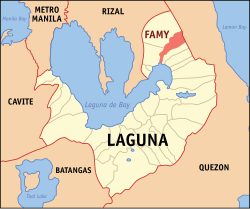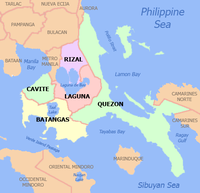Famy
Famy | |
|---|---|
| Municipality of Famy | |
 Downtown area | |
 Seal | |
| Nickname(s): Home of Bamboo Weavers | |
| Motto(s): Bang Gara Aba! | |
| Anthem: Himno ng Famy & Martsa ng Bayan ng Famy | |
 Map of Laguna with Famy highlighted | |
 Famy Location within the Philippines | |
| Coordinates: 14°26′N 121°27′E / 14.43°N 121.45°ECoordinates: 14°26′N 121°27′E / 14.43°N 121.45°E | |
| Country | Philippines |
| Region | Calabarzon |
| Province | Laguna |
| District | 4th district |
| Founded | August 15, 1910 [1] |
| Barangays | 20 (see Barangays) |
| Government | |
| • Type | Sangguniang Bayan |
| • Mayor | Gertrudes S. Andaya |
| • Vice Mayor | Markdel A. Ferrer |
| • Representative | Benjamin C. Agarao Jr. |
| • Municipal Council | Members |
| • Electorate | 12,620 voters (2019) |
| Area | |
| • Total | 53.06 km2 (20.49 sq mi) |
| Elevation | 265 m (869 ft) |
| Highest elevation | 835 m (2,740 ft) |
| Lowest elevation | 1 m (3 ft) |
| Population (2020 census) [4] | |
| • Total | 16,791 |
| • Density | 320/km2 (820/sq mi) |
| • Households | 3,611 |
| Economy | |
| • Income class | 5th municipal income class |
| • Poverty incidence | 10.18% (2015)[5] |
| • Revenue | ₱85,348,462.09 (2020) |
| • Assets | ₱154,131,580.80 (2020) |
| • Expenditure | ₱83,922,514.53 (2020) |
| • Liabilities | ₱62,937,434.46 (2020) |
| Service provider | |
| • Electricity | First Laguna Electric Cooperative (FLECO) |
| Time zone | UTC+8 (PST) |
| ZIP code | 4021 |
| PSGC | |
| IDD : area code | +63 (0)49 |
| Native languages | Tagalog |
| Website | www |
Famy, officially the Municipality of Famy (Tagalog: Bayan ng Famy), is a 5th class municipality in the province of Laguna, Philippines. According to the 2020 census, it has a population of 16,791 people, [4] making it as the least populated municipality in the province.
Famy lies in the north-eastern part of the province of Laguna via Manila East Road. It has a total land area of 3.297 square miles (8.54 km2) which is bounded by the town of Real, Quezon, in the east, in the north by Santa Maria, in the west by Mabitac and Santa Maria, and in the south by Siniloan and Mabitac.
History[]
The history of the town as a barrio of Siniloan dates back to the year 1612 when its natural resources were first exploited by the busy hands of home seekers from Daraitan, Tanay, Rizal. These home seekers named the place Calumpang, after a big shady Calumpang tree that grows in the heart of the place.[6]
Year after year, the inhabitants of the place increased. People from nearby towns were attracted to the barrio because of the vast area of uncultivated lands. After years of struggle for development, they succeeded in making the lands suitable for food crops. They especially made use of the lowlands where more of the inhabitants settled. Home industries gained interest among women. Spiny bamboos were planted as raw materials for the basket industry that remained an important industry in the present time.[6]
In the year 1835, when the people realized the changes of the place, from the bedlam of wilderness to a barrio worthy of becoming a town, they for the first time, sought to become a municipality with its own government. The plan was rejected because of the meager population of the barrio. The people did not lose hope. Again the prominent men of the barrio tried to secure the separation. Stimulated by the feeling of patriotism, men from the barrio voluntarily presented themselves as revolutionist claiming that they will fight on the side of General Emilio Aguinaldo, if the General will help making the barrio a town. So after the revolution, the President of the Republic of the Philippines ordered that Calumpang be separated from the Municipality of Siniloan. Barrio Calumpang was then renamed FAMY. This was in memory of General Emilio Aguinaldo's mother, Mrs. Trinidad Aguinaldo y Famy.[6]
When the American took possession of the Philippines, the form of government automatically changed. With an Executive Order, small towns became barrios of nearby towns. Famy was affected by this order, and again became a barrio of Siniloan. In spite of these changes the people continued the development of the barrio. They tried their best to increase the area of cultivated lands. The inhabitants of this municipality were not satisfied of being a barrio again of Siniloan, so they filed a request to the Governor General that Famy be a town again, citing that no salary for services rendered will be asked and that the municipal hall and school buildings shall be constructed, all on the help of the town's people. By virtue of this request, the Governor General issued Executive Order No. 60 series of 1910, separating Famy from the Municipality of Siniloan, Laguna. This order took effect on August 15, 1910.[6]
Barangays[]

Famy is politically subdivided into 20 barangays.[7]
Climate[]
| Climate data for Famy, Laguna | |||||||||||||
|---|---|---|---|---|---|---|---|---|---|---|---|---|---|
| Month | Jan | Feb | Mar | Apr | May | Jun | Jul | Aug | Sep | Oct | Nov | Dec | Year |
| Average high °C (°F) | 26 (79) |
27 (81) |
29 (84) |
31 (88) |
31 (88) |
30 (86) |
29 (84) |
29 (84) |
29 (84) |
29 (84) |
28 (82) |
26 (79) |
29 (84) |
| Average low °C (°F) | 22 (72) |
22 (72) |
22 (72) |
23 (73) |
24 (75) |
25 (77) |
24 (75) |
24 (75) |
24 (75) |
24 (75) |
24 (75) |
23 (73) |
23 (74) |
| Average precipitation mm (inches) | 58 (2.3) |
41 (1.6) |
32 (1.3) |
29 (1.1) |
91 (3.6) |
143 (5.6) |
181 (7.1) |
162 (6.4) |
172 (6.8) |
164 (6.5) |
113 (4.4) |
121 (4.8) |
1,307 (51.5) |
| Average rainy days | 13.4 | 9.3 | 9.1 | 9.8 | 19.1 | 22.9 | 26.6 | 24.9 | 25.0 | 21.4 | 16.5 | 16.5 | 214.5 |
| Source: Meteoblue [8] | |||||||||||||
Demographics[]
| Year | Pop. | ±% p.a. |
|---|---|---|
| 1903 | 1,262 | — |
| 1918 | 1,095 | −0.94% |
| 1939 | 1,547 | +1.66% |
| 1948 | 1,569 | +0.16% |
| 1960 | 4,163 | +8.47% |
| 1970 | 4,651 | +1.11% |
| 1975 | 5,222 | +2.35% |
| 1980 | 5,241 | +0.07% |
| 1990 | 7,928 | +4.23% |
| 1995 | 9,661 | +3.77% |
| 2000 | 10,419 | +1.63% |
| 2007 | 13,577 | +3.72% |
| 2010 | 15,021 | +3.75% |
| 2015 | 16,587 | +1.91% |
| 2020 | 16,791 | +0.24% |
| Source: Philippine Statistics Authority [9] [10] [11][12] | ||
In the 2020 census, the population of Famy, Laguna, was 16,791 people, [4] with a density of 320 inhabitants per square kilometre or 830 inhabitants per square mile.
Economy[]
| Poverty Incidence of Famy | |
| Source: Philippine Statistics Authority[13][14][15][16][17][18] | |
References[]
- ^ "Amabell Buenzalida".
- ^ Municipality of Famy | (DILG)
- ^ "2015 Census of Population, Report No. 3 – Population, Land Area, and Population Density" (PDF). Philippine Statistics Authority. Quezon City, Philippines. August 2016. ISSN 0117-1453. Archived (PDF) from the original on May 25, 2021. Retrieved July 16, 2021.
- ^ a b c Census of Population (2020). "Region IV-A (Calabarzon)". Total Population by Province, City, Municipality and Barangay. PSA. Retrieved 8 July 2021.
- ^ https://psa.gov.ph/sites/default/files/City%20and%20Municipal-level%20Small%20Area%20Poverty%20Estimates_%202009%2C%202012%20and%202015_0.xlsx; publication date: 10 July 2019; publisher: Philippine Statistics Authority.
- ^ a b c d "Mabitac". Government of the Philippines Department of the Interior. 8 May 2014. Retrieved 1 November 2020.
 This article incorporates text from this source, which is in the public domain.
This article incorporates text from this source, which is in the public domain.
- ^ Philippine Standard Geographic Code listing for Famy – National Statistical Coordination Board
- ^ "Famy: Average Temperatures and Rainfall". Meteoblue. Retrieved 11 May 2020.
- ^ Census of Population (2015). "Region IV-A (Calabarzon)". Total Population by Province, City, Municipality and Barangay. PSA. Retrieved 20 June 2016.
- ^ Census of Population and Housing (2010). "Region IV-A (Calabarzon)". Total Population by Province, City, Municipality and Barangay. NSO. Retrieved 29 June 2016.
- ^ Censuses of Population (1903–2007). "Region IV-A (Calabarzon)". Table 1. Population Enumerated in Various Censuses by Province/Highly Urbanized City: 1903 to 2007. NSO.
- ^ "Province of Laguna". Municipality Population Data. Local Water Utilities Administration Research Division. Retrieved 17 December 2016.
- ^ "Poverty incidence (PI):". Philippine Statistics Authority. Retrieved 28 December 2020.
- ^ https://psa.gov.ph/sites/default/files/NSCB_LocalPovertyPhilippines_0.pdf; publication date: 29 November 2005; publisher: Philippine Statistics Authority.
- ^ https://psa.gov.ph/sites/default/files/2003%20SAE%20of%20poverty%20%28Full%20Report%29_1.pdf; publication date: 23 March 2009; publisher: Philippine Statistics Authority.
- ^ https://psa.gov.ph/sites/default/files/2006%20and%202009%20City%20and%20Municipal%20Level%20Poverty%20Estimates_0_1.pdf; publication date: 3 August 2012; publisher: Philippine Statistics Authority.
- ^ https://psa.gov.ph/sites/default/files/2012%20Municipal%20and%20City%20Level%20Poverty%20Estima7tes%20Publication%20%281%29.pdf; publication date: 31 May 2016; publisher: Philippine Statistics Authority.
- ^ https://psa.gov.ph/sites/default/files/City%20and%20Municipal-level%20Small%20Area%20Poverty%20Estimates_%202009%2C%202012%20and%202015_0.xlsx; publication date: 10 July 2019; publisher: Philippine Statistics Authority.
External links[]
| Wikimedia Commons has media related to Famy, Laguna. |
- Municipalities of Laguna (province)
- Populated places on Laguna de Bay



